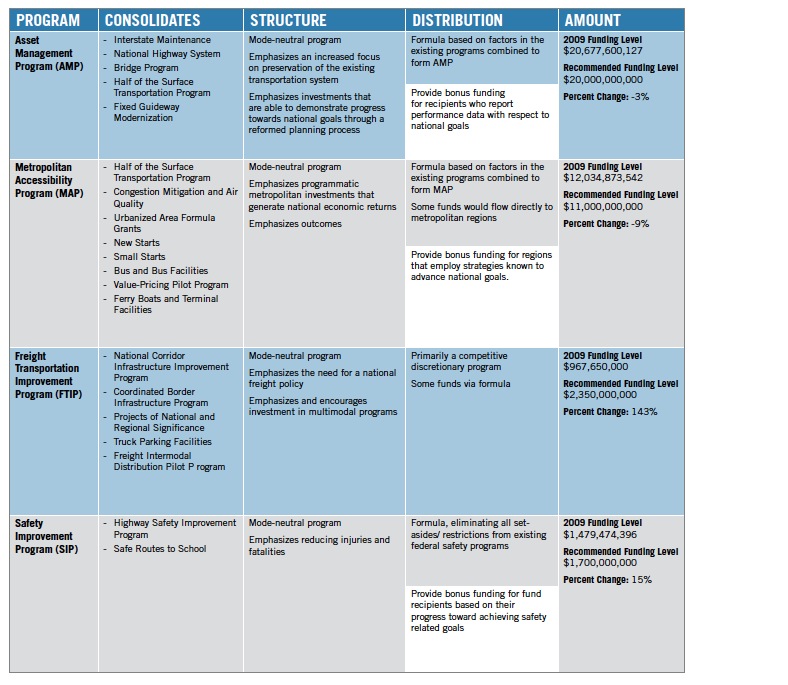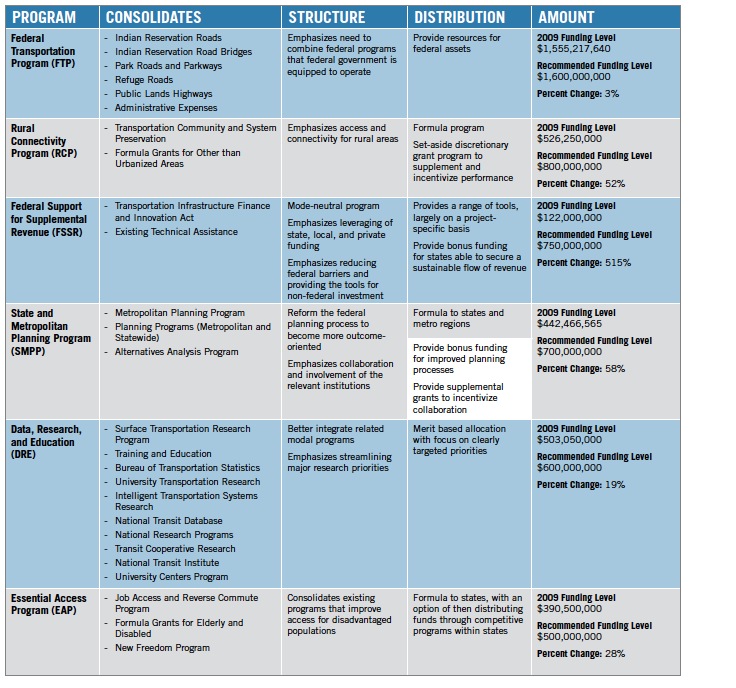BIPARTISAN POLICY CENTER
Executive Summary
Our nation faces substantial challenges. In the current environment of economic hardship and unsustainable budget deficits, tough decisions are required. However, political partisanship and division make collaborative and timely decision-making extremely difficult. And yet, as at other points in our nation’s history, trying times can create new opportunities to confront some of America’s most compelling challenges.
In particular, the looming budget challenges that have stymied progress on a new surface transportation bill can provide the impetus for needed reform of the federal program. Both parties should seize this moment to push forward a thoughtful, equitable, sustainable, and well-targeted federal approach to transportation policies and investments that help our economy grow, improve the energy and environmental sustainability of our transportation system, and improve the safety and quality of life in our nation.
In this report, the Bipartisan Policy Center’s National Transportation Policy Project (NTPP) builds on its June 2009 report, Performance Driven: A New Vision for U.S. Transportation Policy, to propose a set of practical near-term actions that are responsive to current political and fiscal conditions but represent a substantial step towards that original vision. The central goal, as articulated in that 2009 report, remains a federal surface transportation program that is more performance-based and accountable and therefore better equipped to meet the economic and environmental challenges we face in the years ahead.
Specifically, this proposal outlines immediate steps that can be taken to:
1. restructure the existing federal surface transportation program to be more performance-driven; and
2. better leverage non-federal resources.
The Need for Reform
For years there has been overwhelming evidence that the U.S. is failing to maintain its highways, bridges, and transit systems, and consistently falling short in making the infrastructure investments needed to provide for the long-term needs of our growing population and economy. The recognition that we are under-investing in our transportation systems, however, has run headlong into a political and fiscal environment in which expanding federal expenditures for any purpose is increasingly difficult to discuss, much less to enact. In this context it is arguably more important than ever to ensure that all federal resources directed to transportation—albeit never enough to keep pace with the nation’s vast and growing transportation needs—are invested wisely.
This NTPP report proposes a new programmatic framework for federal transportation spending. The approach we recommend is organized around ten focus areas, each of which addresses one or more of the core national interests articulated in the 2009 report. This report assumes that federal funding for transportation will be reduced to roughly current levels of incoming revenue—that is, approximately $40 billion per year. We developed this proposal bearing in mind that should increased funding become available in the near term, the programmatic structure recommended could absorb additional resources while still allocating them in a more targeted, efficient way.
NTPP’s 2009 report framed a long-term vision and program structure designed to bring accountability and a clearer sense of purpose to the federal surface transportation program. This report develops a more detailed set of near-term recommendations aimed at introducing a more performance-driven focus into the next surface transportation authorization bill.
As in our 2009 report, these recommendations proceed from the central premise that any amount of federal investment in transportation should advance specific national purposes. These purposes must be articulated by Congress as part of any new, federal surface transportation authorizing legislation.
NTPP’s 2009 report proposed five key goals, all of which are central to the national interest and require federal leadership and action:
- Economic Growth—producing maximum economic growth per dollar of investment
- National Connectivity—connecting people and goods across the nation with effective surface transportation
- Metropolitan Accessibility—providing efficient access to jobs, labor, and other activities throughout metropolitan areas
- Energy Security and Environmental Protection—integrating energy security and environmental protection objectives with transportation policies and programs
- Safety—improving safety by reducing the number of accidents, injuries, and fatalities associated with transportation
It is imperative for Congress to articulate specific national goals in the next surface transportation bill. This is the only way we will be able to move from a disparate and fragmented federal program with many narrow and often uncoordinated interests to one that is more performance-based and able to effectively prioritize and target investments.
The U.S. Department of Transportation (U.S. DOT), in collaboration with states and metropolitan regions, should be directed through legislation to develop performance measures for evaluating progress toward these goals. Recipients of federal funding should thereafter be held accountable for demonstrating progress toward agreed upon metrics. Performance metrics could include access to jobs and labor, and non-work activities; network utility; corridor congestion; petroleum consumption; carbon emissions; and fatalities and injuries per capita and per vehicle miles traveled.
…
Final Word
Current budget realities pose a major challenge for the U.S. transportation system. In this climate of extraordinary constraint, action is needed to generate new ideas and measures that may not have been possible under other circumstances. Now is the time to make more efficient use of scarce resources.
The reality is that federal transportation spending is likely to be under enormous pressure for some time to come, despite compelling evidence that we have been falling consistently short of making the infrastructure investments needed to sustain an efficient, safe, environmentally sustainable, and well-functioning national transportation network.
In the long term, the programmatic framework proposed in this report allows for the achievement of wiser investments. It offers a sound strategy for securing broad public support for policies and resource commitments that will allow the U.S. to continue to achieve high standards of living and remain competitive in a highly mobile, global economy. It provides a way to make substantial investment and tangible improvement to the vital transportation systems on which our nation depends.
Download full version (PDF): Performance Driven
About Bipartisan Policy Center
www.bipartisanpolicy.org
“The Bipartisan Policy Center is a non-profit organization that was established in 2007 by former Senate Majority Leaders Howard Baker, Tom Daschle, Bob Dole and George Mitchell to provide a forum where tough policy challenges can be addressed in a pragmatic and politically viable manner. The Bipartisan Policy Center’s National Transportation Policy Project (NTPP) is bringing new voices to the transportation debate and creating a dynamic and enduring framework for the next authorization bill and beyond. With billions of dollars on the line, our diverse group of members believes we need to rethink old assumptions and move beyond the status quo.”
Tags: bipartisan policy center, BPC, Congress, Environment, National Transportation Policy Project








 RSS Feed
RSS Feed